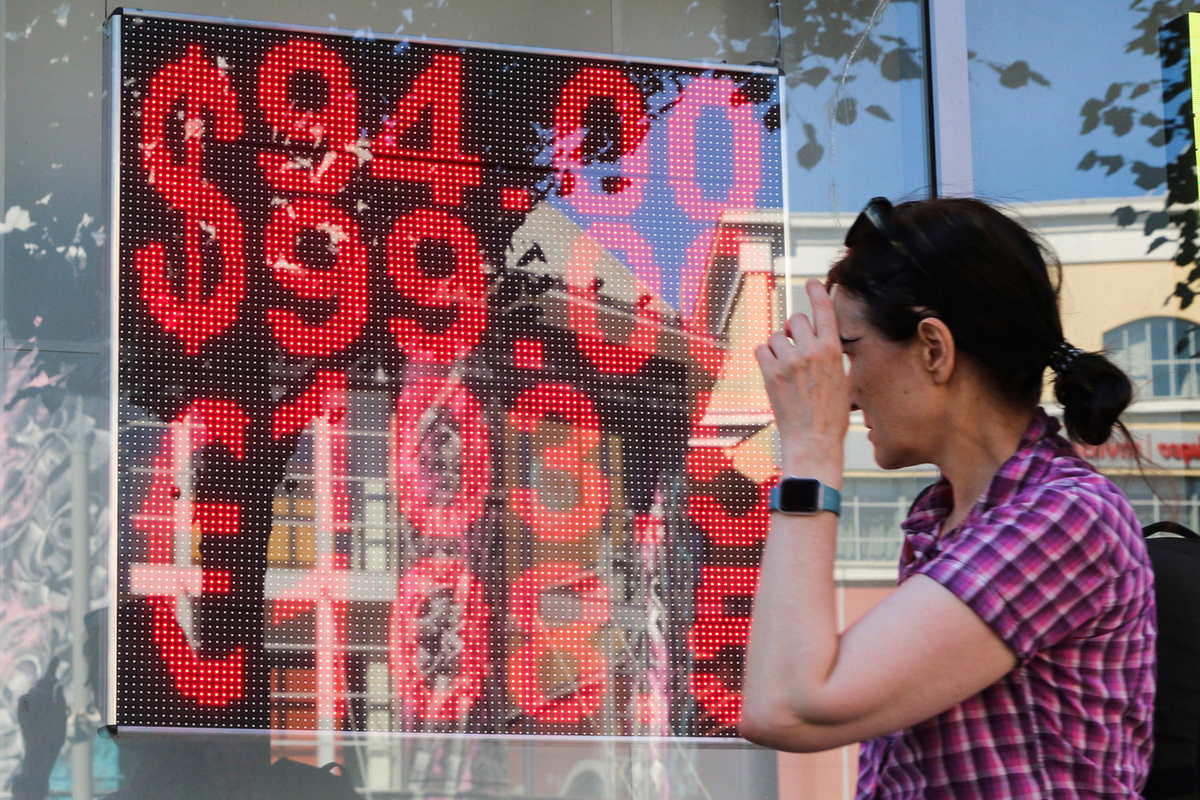Experts named the conditions for the collapse of the ruble
[ad_1]

What will be the outcome of the repeal of the decree on the mandatory sale of foreign currency earnings?
On April 16, the dollar exchange rate on the Moscow Exchange broke through the level of 94 rubles, which happened for the first time since October 30. Then the European currency also surpassed the “psychological” level of 100 rubles, although since April 13 it did not dare to storm this height. Why the movement of the two most important world currencies against the ruble is so uneven and what will happen next with their exchange rate, MK found out from experts.
The US dollar is becoming more expensive not only against the ruble, but also against most world currencies. “The dollar index DXY (the ratio of the value of the dollar to a basket of 6 reserve currencies) has increased by almost 2% since April 10 amid changes in expectations for the monetary policy of the Federal Reserve System (FRS) due to the publication of inflation data in March 2024 higher forecast,” says Freedom Finance Global analyst Vladimir Chernov.
It is curious that the American currency is becoming more expensive even against the euro. Since most foreign trade transactions are carried out in American dollars, the demand for them on the stock exchange is higher. In fact, the dollar and the euro have diverged since the beginning of the year. According to investment advisor at IC Fontvielle Maxim Fedorov, in the first quarter of 2024 the ruble weakened against the dollar by 2.3%, and remained unchanged against the euro. The exception was last week, when the national currency lost 1% against the dollar and strengthened by 0.5% against the euro, that is, we can say that, starting from last week, the trend of diverging paths between the dollar and the euro has intensified. The reason here should be sought in the policies of the two largest central banks – the European (ECB) and the American (Fed), in which there has been a divergence. Despite the fact that the ECB did not change anything last week for the fifth meeting in a row, the rhetoric of the head of the regulator, Christine Lagarde, was dovish, which suggests that the cycle of easing monetary policy may begin in the summer.
At the same time, in the United States, a fairly strong labor market and high economic activity are preventing inflation from slowing down to the goal announced by the Fed – 2% per annum. This means that the cycle of lowering interest rates in the United States is postponed until the second half of the year. Interest rates have an impact on foreign exchange markets: the higher the expectation that they will go down, the weaker the national currency feels. That is why on Friday, April 12, the European currency fell to its lowest level since November 2023 against the American currency. And this trend is reflected in the fluctuations of the dollar and euro against the ruble. “I expect that the impact of the divergent policies of the ECB and the Fed will actively make itself felt in the next few months,” says Fedorov. — This means that the ruble will weaken against the dollar more than against the euro. The latter may even see a slight strengthening based on the results of the second quarter.”
If we talk about the factors influencing the ruble that exist in Russia itself, then for several weeks now analysts have been waiting for signals from the government on whether the presidential decree on the mandatory sale of foreign currency earnings by exporters, which ends on April 30, will be extended. At the same time, there is debate in high places about its influence on the exchange rate. Thus, the government has noted its effectiveness several times, and the Central Bank of the Russian Federation believes that the ruble exchange rate is affected by the trade balance and the regulator’s strict monetary policy (that is, a high key rate).
Analysts have differing opinions regarding the final decision of the authorities. “The authorities are monitoring fundamental factors, such as the cost of oil, capital outflow and others, but are unlikely to allow the ruble to weaken above 95 rubles per dollar,” says Associate Professor of the Department of Global Financial Markets and Fintech at the Russian Economic University. Plekhanov Denis Perepelitsa. If the ruble weakens further, then most likely the presidential decree on the mandatory sale of foreign currency earnings will be extended and then the ruble may strengthen to 92 rubles per dollar, the scientist predicted.
If the presidential decree is extended beyond April 30, the ruble exchange rate will remain stable and will most likely trade in the range of 93–96 rubles per dollar. If it is cancelled, then analyst Chernov predicts an increase in the dollar exchange rate to 96–99 rubles. At the same time, by the end of this week, the dollar exchange rate may well have time to reach 95 rubles, the euro exchange rate will gain a foothold above 100 rubles, and the yuan exchange rate will try to gain a foothold above 13 rubles, the expert believes.
[ad_2]
Source link






